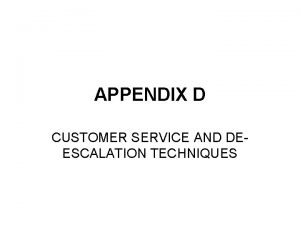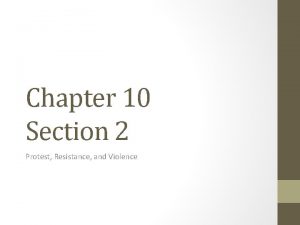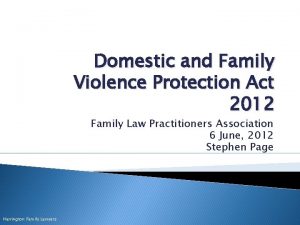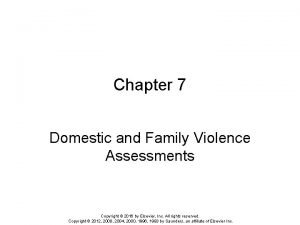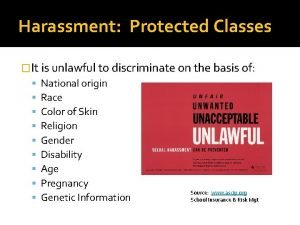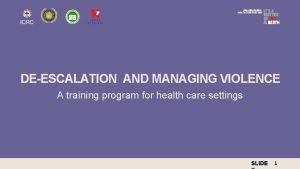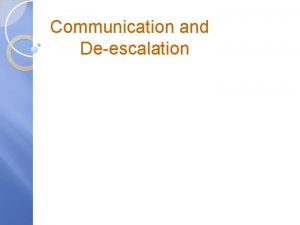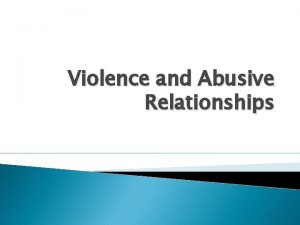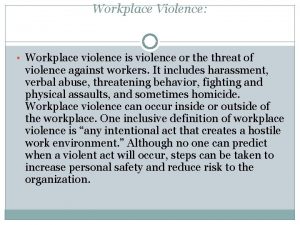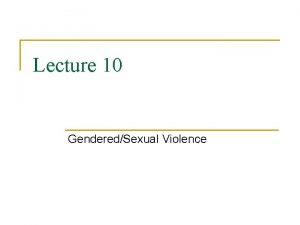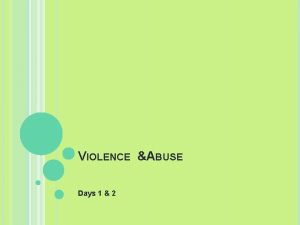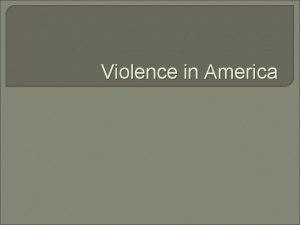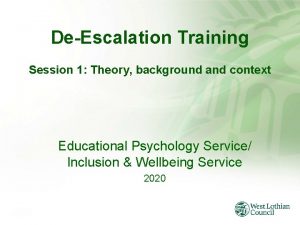DEESCALATION AND MANAGING VIOLENCE A training program for



































































- Slides: 67

DE-ESCALATION AND MANAGING VIOLENCE A training program for health care settings SLIDE 1

Introduction of the Trainers SLIDE 2

Activity 1 Introduce yourself to your partner. Tell him/her: Name plate Your name Work experience Your designation An interesting fact about yourself SLIDE 3

Overview of the curriculum and training schedule Module Topics Purpose Introduction of trainers and participants Pre training assessment (Pre-Test) 1 Introduction to the Health Care in Danger Understand the rationale for the training, Project and the Research on Violence involve participants and create against health conducted in Karachi contextual relevance 2 3 Duration 15 min Time 9: 00 am 9: 15 am 45 min 9: 30 am Understanding violence, its types & consequences on HCP Discuss types of violence and their effect on HCP De-escalating violent situations Identify warning signs in a situation with a potential to turn violent; Demonstrate behaviors that are helpful in preventing violence; Suggest ways of dealing with situations that have become violent 90 min 10: 15 am Realize the roles of communication and demonstration of compassion in preventing violent situations 90 min 11: 45 pm 15 min 12: 45 pm 1: 00 pm Importance of Communication in Health Care Summarization of key learning points, Feedback and Post-test Concluding Remarks and Lunch SLIDE 4

Activity 1 (Cont. ) What are your learning expectations for the workshop? SLIDE 5

Training Objectives The objective of the workshop is to help medical personnel: 1. understand the impact of trauma on their bodies and hence to better equip them to deal with the aftermath of violence at an individual and institutional level; 2. understand what leads to escalation and the process of de- escalation which would improve their efficacy in dealing with violence; 3. deal with a patient’s attendants in a more empathic manner SLIDE 6

MODULE 1 Understanding Violence & Stress SLIDE 7

Violence • World Health Organization (WHO) defines violence as "the intentional use of physical force or power, threatened or actual, against oneself, another person, or against a group or community that either results in or has a high likelihood of resulting in injury, death, psychological harm, maldevelopment, or deprivation. " • According to the International Federation of Red Cross (IFRC), the basis of any violence is misuse of power. SLIDE 8

Introduction to Health Care in Danger project The Health Care in Danger project is an initiative of the International Red Cross and Red Crescent Movement that aims to improve security and delivery of impartial and efficient health care in areas experiencing armed conflict and other emergencies. SLIDE 9

Results from a Multi-Center Study in Karachi Some of the important questions answered by the study: 1. is violence experienced in a health care setting? 2. who is the target? 3. who is the perpetrator? 4. why does it happen? 5. what happens to HCP who experience violence? SLIDE 10

Figure 1: Predominant Nature of Violence Experienced or Witnessed (n=542) SLIDE 11

Figure 2: Chief Perpetrators in the Events of Violence Experienced /Witnessed (n=542) SLIDE 12

Figure 3: Predominant Factors that Played a Role in the Development of an Incident (n=542) SLIDE 13

Figure 4: Predominant Effect of Violence on Victim (n=549) SLIDE 14

The results indicate The above results indicate that health care providers are working in an environment characterized by a multitude of conflicts and types of violence; these conditions might lead to stress or Post Traumatic Stress Disorder. SLIDE 15

Activity 2 Discuss with your partner and then share your personal experiences of violence in daily life and the workplace. SLIDE 16

How does being exposed to violence affect you? SLIDE 17

What happens to the body? • The nervous system releases a flood of stress hormones, including adrenaline and cortisol, which rouse the body for emergency action. • The heart pounds faster. • Muscles tighten. • Blood pressure rises; breathing quickens. • All of these changes prepare you to either fight the threat or run away to save yourself. SLIDE 18

What happens to the brain in a fight/flight response? • The emotional center of the brain senses the threat. • Fear-based responses overcome you. • Your critical thinking is impaired. • Judgment is impaired. • The power to make decisions is weakened. • The frontal lobe that is responsible for logical thinking and decision making shuts down and the “limbic system” (the emotional brain) takes over. SLIDE 19

What happens to the body afterwards? When the threat has passed, the body tries to regain its natural balance. Heart beat, blood pressure, muscle tension all come back to normal. Is your body always able to regain its natural balance? SLIDE 20

NO SLIDE 21

What happens when the balance is not restored? • The excessive energy that is released during the threatening situation often stays in the body and later appears as a symptom of stress. • Your blood pressure still stays high even if the threat is gone. • You stay alert without any reason (can’t sleep or relax). • The body experiences aches and pains for no apparent reason. • The immune system is compromised. SLIDE 22

If the exposure to violence continues and threat is present; you might develop stress or Post Traumatic Stress Disorder depending on the extent of the impact on you. SLIDE 23

Post-Traumatic Stress Disorder Any physical, emotional, or psychological anxiety continued to be experienced after safety has resumed. Exposure to violence/traumatic event Emotional and/or physical disturbance This disturbance lasts for a few weeks SLIDE 24

Trauma can get stored in your body; WHAT THE MIND FORGETS THE BODY REMEMBERS Babette Rothschild SLIDE 25

What are the symptoms of PTSD? • Isolation • Negative mood • Negative thoughts • Alertness without threat • Avoidance of reminders of the incident • Bad memories • Nightmares SLIDE 26

Normal Emotional Reactions to Traumatic Events • Shock and disbelief • Fear • Sadness • Helplessness • Guilt • Anger • Shame • Racing thoughts SLIDE 27

Look at the graph and tell us if you think health care professionals in Karachi might be going through PTSD SLIDE 28

Activity 3 How many of these symptoms have you experienced? SLIDE 29

Relational Trauma • When your trauma is not understood • When people around you say things about your job, such as “Why are you even bothered by what happened? Let it go, ” it makes you feel misunderstood and may lead to isolation and/or not sharing your feelings. SLIDE 30

What can you do? • Meditation • Exercise (it helps release the stored energy) • Mindfulness SLIDE 31

Recovery tips • Spend time with loved ones. • Connect with other survivors. • Encourage support groups especially at your workplace. • Heal but don’t try to force the healing process • Sharing helps. • Please reach out for professional help if symptoms persist. SLIDE 32

Activity 4 Develop your own coping strategy: please write down two ways that you can reduce stress and the effects of violence on yourself and at the workplace. SLIDE 33

Thank You SLIDE 34

MODULE 2 Escalation and De-escalation SLIDE 35

Objective In this module we will: • Understand the cycle of escalation: why and how a conversation turns into an assault? • Practice de-escalation: What can we do to control the process of escalation? SLIDE 36

Classification of violence Proactive Safety measures Reactive Deescalation Instrumental/Proactive Violence: A coldblooded, pre-planned act of violence to gain some reward e. g: bomb blast, target killing. Response: Enhanced safety, fleeing from the scene. Reactive Violence: Emotional, angry, affective aggression to take revenge. Or to retaliate to provocation, carried out in anger, in frustration, in a heightened emotional state. Response: Use de-escalation strategies. SLIDE 37

THIS TRAINING ONLY COVERS RESPONSE TO AND PREVENTION OF REACTIVE VIOLENCE SLIDE 38

Simulation exercise SLIDE 39

Map the Cycle of Escalation SLIDE 40

Facts about Escalation • Things escalate because someone is trying to win an argument. • Things escalate when someone is judgmental. • Escalation happens because two people are in conflict and are dysregulated. • Escalation happens because both people are trying to convey what they mean and neither one is listening. • When someone attacks you, your first response is to defend yourself; this causes stress and an adrenaline rush. The aggressor is experiencing the exact same reactions. So this makes two dysregulated persons. If you remain calm, this will automatically lead to de-escalation. SLIDE 41

Escalation: What are the Early Signs? • Tense body language (yours or the other person’s) • Taking up personal space • Touching or grabbing to emphasize your point • Raised voice • Rapid speech • Excessive sweating • Excessive hand gestures: balled fists, hands on the hips etc. SLIDE 42

Aggression and Escalation Signals Recurrent or frequent queries Be polite and appear calm Shoulders squared and dominating Stand adjacent - not in front Tight jaw with clenched teeth Open your hands Clenched fist or pointing fingers Be consistent and empathetic Staring Break eye contact SLIDE 43

Assaulting private space Give space Using offensiveness or cynicism Do not be provocative Shouting Use a calm tone of voice Wandering Gently instruct to sit down Hasty breathing Allow them to relax SLIDE 44

De-Escalation: bringing the level of agitation down in a situation Reasoning with an enraged person is not possible. The first and only objective in de-escalation is to reduce the level of agitation so that discussion becomes possible. De-escalation techniques are counterintuitive. Our mind prepares the body to fight, flight or freeze when scared. However, in de-escalation, we can do none of these. We must appear centered and calm even when we are frightened. Practice ahead so that the strategies can become "second nature. ” SLIDE 45

Unhelpful attitudes for de-escalation: Give an example of each Do not ignore Do not try to convince Do not be judgmental The don’ts of de-escalation Do not be reactive Do not use sarcasm Do not defend SLIDE 46

Consolidation What will you do when you are dysregulated? SLIDE 47

MODULE 3 Patient communication protocol SLIDE 48

Objectives • To help medical personnel create a protocol for communicating with patients; • To improve their listening skills; • To highlight empathic communication. SLIDE 49

Basics of patient communication: Active listening How can you show your patients that: You have heard them You have understood them You have felt their worry • Pay attention (face them, make eye contact) • Repeat what you have heard • Paraphrase: tell them what you understood from their speech • Use phrases like; “aap ka matlab hai…, aap chatey hain” • Tell them how you think they might be feeling • Communicate/reflect their said or unsaid feelings SLIDE 50

Video of active listening SLIDE 51

Normal protocol of communication • First greet the patient(s) • Introduce yourself and what you do. • Tell them that you are going to talk to them right after you have examined the patient (FOR ATTENDANTS). • Examine the patient and then communicate your assessment. • They need to receive clear explanations and instructions about their condition; it is reasonable. • Adequate information must be shared with patients and/or their attendants. This would include clinical, management and even prognostic information. This increases the understanding of the concept of self-care and individual health promotion. SLIDE 52

Normal protocol of communication • Tell them about available treatment options. • Help them decide; do not decide for them right away. This will make them feel more empowered. • Use active listening. • Do not use medical jargon. • Go through important information slowly; be especially careful not to rush through negative information. If you have to repeat yourself, that is fine. SLIDE 53

Empathize with your patient: What is empathy? • Ability to feel another’s pain and happiness. • No judgment (You ate salad last night; that’s why your stomach hurts). • Taking perspective (seeing things from other’s point of view). • Recognizing emotion and communicating that (You look really worried). • Offering help rather than solutions (Instead of saying “roney ka koi faida nahin hai; ” you can say, “How can I make you feel better? ”). • Refraining from giving explanations or your opinion on the issue. • Don’t force positivity (by saying, e. g. , “You should think about your blessings; be positive”). SLIDE 54

What helps you empathize? Mirror Neurons Seeing someone smile brings a smile to your own face. Someone’s tears make your eyes wet even if you do not know the story. In these instances your mirror neurons are activated; they have the ability to mirror (copy) other people’s emotions and gestures; this helps us share experiences with others. This is an automatic and involuntary (something which we have no control over) process of the brain. SLIDE 55

Compassion Fatigue This is when you are burnt out and cannot show empathy any more. For doctors and medical staff, the capacity to empathize tends to wear them out after a time. They see so much misery and pain that after a time, although their mirror neurons register the experience, they do not fully feel it. The symptoms of compassion fatigue are those of chronic stress which we discussed earlier. SLIDE 56

Self-care is essential in your profession. You can reach out for further support if WPV has affected you deeply. Please practice the discussed strategies and give us feedback. Thank you for your time & attention. These are not the only ways to deal with violence. Violence is not part of your job – it is never justified. Please meet in smaller groups to create a support network. SLIDE 57

Breaking Bad News SLIDE 58

Simulation exercise SLIDE 59

What is bad news? “Information likely to drastically alter a patient’s view of his or her future. ” (Beckman, 1992) “…situations where there is either a feeling of no hope, a threat to one’s mental or physical well-being, a risk of upsetting an established lifestyle, or where the message given conveys fewer choices in his or her life…” SLIDE 60

How bad news is given is important “…some unhappiness is caused by what the client is hearing, but dissatisfaction with the way they hear it is most commonly caused by: • The doctor not listening or not appearing to listen • The doctor using jargon • The doctor talking down to the patient” SLIDE 61

Step 1: Setting up the meeting Arrange for important family members to be present; try to get a separate, private place (select a Always remember !!! place with no access to sharp instruments or any hazardous material which can be used against you in case of escalation of aggression or violent behavior) • If the news is serious or the patient is dead, identify the most appropriate person among attendants and take this person to a separate room. Ideally you should have another healthcare team member with you (if that is not possible let the other doctors/ nurses/ receptionist/guard know that you are with the patient/attendant to break • Delay the bad news and first tell the attendants to pray as the patient’s condition the bad news) is serious (even if the patient is dead). This will divert their attention and you will get time to organize security to be able to deal with the consequences. Be respectful; use appropriate names, keep a comfortable distance, pay attention to your own • In the case of a high risk situation with a higher probability of reactive violence body language, make eye contact. Be conscious of patients/ attendants body language be as a response to bad news, such as death of a public figure / celebrity / watchful for signs of escalation of aggression or signs of violent behaviour (Make sure that you politician or religious leader, always call security forces / guards to the location are sitting/ standing at a place with easy and safe access to exit to door( so you will be able to before breaking the bad news. take off if patient/ attendant gets violent). SLIDE 62

Step 2: Finding out how much the patient or attendant knows. • Utilize your full concentration and listening skills to get to know the patient/attendant’s understanding of the situation. Let the patient/attendant know that you are trying to listen and that you are interested in what s/he thinks is going on. • Be alert for signs of escalation of aggressive behavior such as: I- Recurrent or frequent queries: II- Shoulders squared and dominating III-Tight jaw with clenched teeth IV- Clenched fist or pointing fingers V-Staring VI- Assaulting personal space VII-Using offensiveness or cynicism VIII- Shouting IX- Wandering X- Hasty breathing XI- Abrupt or NO reply SLIDE 63

Step 3: Sharing the Information • Align the information that you are going to provide with what the patient or attendant already knows. This gives them the confidence that you have heard them and understand their concerns. • When delivering bad news make sure you use small sentences and stop frequently while talking. Do not use medical jargon and difficult words. . . • Allow time for silence. This often means that the patient/attendant is thinking or feeling something which is bothering him/her (so be respective of their concerns). • Allow time for tears; offer tissues to convey the message that crying is allowed. Touch the shoulder/arm (if culturally appropriate) or move closer to imply that it is OK to show emotion. SLIDE 64

Step 4: Identify and acknowledge the patient’s reaction. • Offer realistic hopes but avoid trying to be overly reassuring. Remember: “The success or failure of the breaking bad news ultimately depends on how the patient reacts and how you respond to those reactions and feelings. ” • If the patient/attendant becomes violent or tries to harm you, immediately exit the room (push the panic button or safety alarms if available). SLIDE 65

Step 5: Demonstrate an understanding of the patient’s/attendant’s problems. • Arrange for all possible help and assistance in the case the patient has not survived • Provide comfort, a place to sit, water, connect with an ambulance service and see if paper work can be moved quickly. • At all times, demonstrate compassion and respect for the attendants’ loss. SLIDE 66

Thank You SLIDE 67
 Customer service deescalation
Customer service deescalation Fvip
Fvip Adolescent family violence program
Adolescent family violence program Fvip georgia
Fvip georgia Antecedent passion meaning
Antecedent passion meaning Domestic and family violence protection act 2012
Domestic and family violence protection act 2012 Gandhi king and mandela what made non-violence work dbq
Gandhi king and mandela what made non-violence work dbq Chapter 9 lesson 2 resolving conflicts
Chapter 9 lesson 2 resolving conflicts Chapter 27 anger aggression and violence
Chapter 27 anger aggression and violence Chapter 10 section 2 protest resistance and violence
Chapter 10 section 2 protest resistance and violence Domestic and family violence protection act 2012
Domestic and family violence protection act 2012 Chapter 9 resolving conflicts and preventing violence
Chapter 9 resolving conflicts and preventing violence Ebb tide tackle
Ebb tide tackle Framework agreement on harassment and violence at work
Framework agreement on harassment and violence at work Routine, universal screening for domestic violence means
Routine, universal screening for domestic violence means Workplace violence and harassment quiz answers
Workplace violence and harassment quiz answers Seceding states of the confederacy
Seceding states of the confederacy Academy on violence and abuse
Academy on violence and abuse Fspos
Fspos Novell typiska drag
Novell typiska drag Nationell inriktning för artificiell intelligens
Nationell inriktning för artificiell intelligens Returpilarna
Returpilarna Varför kallas perioden 1918-1939 för mellankrigstiden?
Varför kallas perioden 1918-1939 för mellankrigstiden? En lathund för arbete med kontinuitetshantering
En lathund för arbete med kontinuitetshantering Personalliggare bygg undantag
Personalliggare bygg undantag Tidbok för yrkesförare
Tidbok för yrkesförare Sura för anatom
Sura för anatom Förklara densitet för barn
Förklara densitet för barn Datorkunskap för nybörjare
Datorkunskap för nybörjare Tack för att ni lyssnade bild
Tack för att ni lyssnade bild Debattinlägg mall
Debattinlägg mall För och nackdelar med firo
För och nackdelar med firo Nyckelkompetenser för livslångt lärande
Nyckelkompetenser för livslångt lärande Påbyggnader för flakfordon
Påbyggnader för flakfordon Tryck formel
Tryck formel Offentlig förvaltning
Offentlig förvaltning Lyckans minut erik lindorm analys
Lyckans minut erik lindorm analys Presentera för publik crossboss
Presentera för publik crossboss Teckenspråk minoritetsspråk argument
Teckenspråk minoritetsspråk argument Vem räknas som jude
Vem räknas som jude Treserva lathund
Treserva lathund Fimbrietratt
Fimbrietratt Bästa kameran för astrofoto
Bästa kameran för astrofoto Cks
Cks Lågenergihus nyproduktion
Lågenergihus nyproduktion Mat för idrottare
Mat för idrottare Verktyg för automatisering av utbetalningar
Verktyg för automatisering av utbetalningar Rutin för avvikelsehantering
Rutin för avvikelsehantering Smärtskolan kunskap för livet
Smärtskolan kunskap för livet Ministerstyre för och nackdelar
Ministerstyre för och nackdelar Tack för att ni har lyssnat
Tack för att ni har lyssnat Referatmarkeringar
Referatmarkeringar Redogör för vad psykologi är
Redogör för vad psykologi är Matematisk modellering eksempel
Matematisk modellering eksempel Tack för att ni har lyssnat
Tack för att ni har lyssnat Borra hål för knoppar
Borra hål för knoppar Orubbliga rättigheter
Orubbliga rättigheter Hur räknar man standardavvikelse
Hur räknar man standardavvikelse Tack för att ni har lyssnat
Tack för att ni har lyssnat Steg för steg rita
Steg för steg rita Informationskartläggning
Informationskartläggning Tobinskatten för och nackdelar
Tobinskatten för och nackdelar Toppslätskivling effekt
Toppslätskivling effekt Datumr
Datumr Egg för emanuel
Egg för emanuel Elektronik för barn
Elektronik för barn Antika plagg
Antika plagg Strategi för svensk viltförvaltning
Strategi för svensk viltförvaltning
